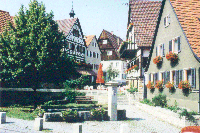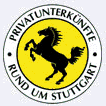
Plieningen was first mentioned in documentation dating back to 1139. After Plieningen burnt down completely in the Thirty Years’ War, industrialisation entered Plieningen without remarkable changes. Notable businesses settled in the first and second half of the 20th century. On 1st April 1942 the site was suburbanised and since 1946 Birkach is administered together with Plieningen. And just like Birkach, Plieningen’s history can be seen through a church. The oldest parts of the Martinskirche in Plieningen are from the 12th century. The site was probably a Pagan place of worship. The twelve sculptures which are spread over the roof cornice are worth seeing.
Today the district of Hohenheim is better known than Plieningen itself. It used to be owned by the lower noblemen of Hohenheim to whom the humanist Theophrast Bombast von Hohenheim, also known as Paracelsus, belonged. The manor changed owners several times in the course of the centuries until it fell back to the Duke Carl Eugen in 1768. He gave it to his later wife Franziska von Leutrum including all estates and had Schloss Hohenheim built in 1785. In 1818 the Agricultural College was founded which was the first of its kind worldwide. This set the cornerstone for the University of Hohenheim of today and its research facilities around the castle and the gardens. Private link about Plieningen.









